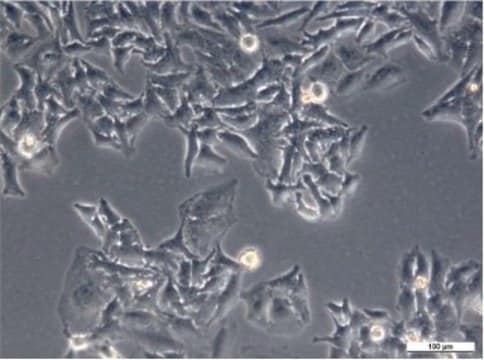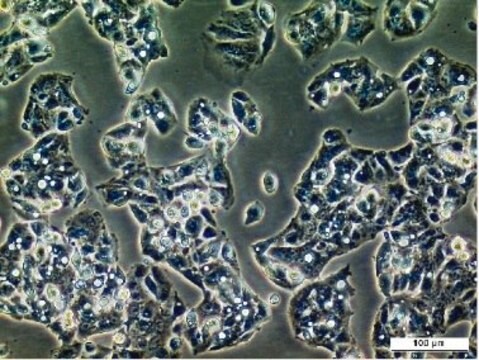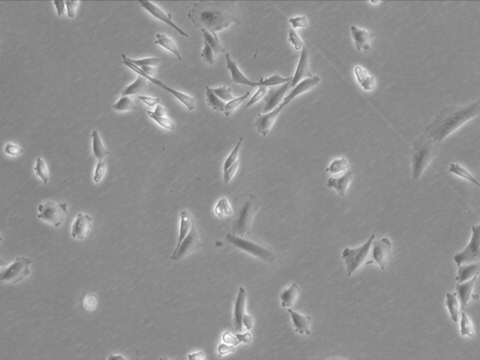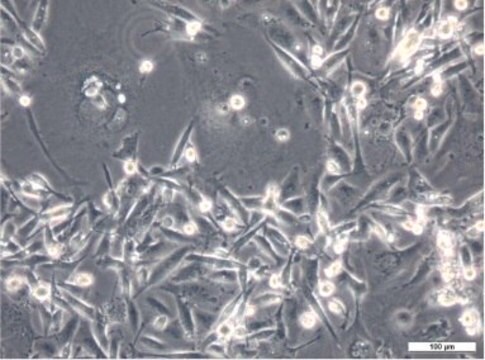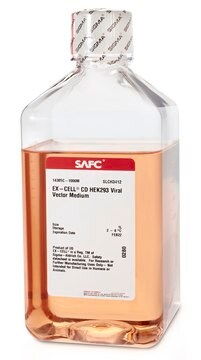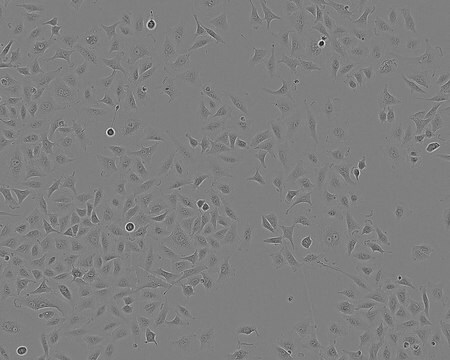293 Cell Line human
NOTE: Both the cell line and DNA from the cell line may be available for this product. Please choose -1VL or VIAL for cells, or -DNA-5UG for DNA, 85120602, human kidney (embryonic), Epithelial
别名:
HEK-293 Cells, HEK293 Cells, Human Embryonic Kidney 293 Cells
登录查看公司和协议定价
所有图片(1)
About This Item
分類程式碼代碼:
41106514
推荐产品
生物源
human kidney (embryonic)
包裝
tube of 5 μg 85120602-DNA-5UG
pkg of vial of cells 85120602-1VL
增長模式
Adherent
染色體組型
2n 46, hypotriploid, modal no. 64
形態學
Epithelial
產品
Not specified
受體
Not specified
技術
cell culture | mammalian: suitable
運輸包裝
dry ice
儲存溫度
−196°C
細胞系來源
Human Embryo Kidney
細胞系描述
Transformed with sheared human Ad5 DNA. Sensitive to human adenoviruses and adenovirus DNA. Can be used to isolate transformation defective host-range mutants of Ad5 and for titrating human adenoviruses. This is a hypotriploid human cell line. The modal chromosome number was 64, occurring in 30% of cells. The rate of cells with higher ploidies was 4.2%. The der (1)t(1;15) (q42;q13), der(19)t(3;19)(q12;q13),der(12)t(8;12) (q22;p13) and four other marker chromosomes were common to most cells. Five other markers occurred in some cells only. The marker der(1) and M8 (or Xq+) were often paired. There were four copies of N17 and N22. Noticeably in addition to three copies of X chromosomes, there were paired Xq+ and a single Xp+ in most cells. The Ad insert was shown to consist of a colinear segment from nucleotides 1 to 4344 integrated into chromosome 19 (19q13.2). Expression of an unusual cell surface receptor for vitronectin has been reported. This is composed of the integrin β-1 subunit and the vitronectin receptor α-v subunit. Detach at room temperature; may take up to seven days to reattach.
應用
The human embryonic kidney 293 cell line has been used:
- to study the effects of the Bt insecticidal toxins Cry1Ab and Cry1Ac alone, or with a glyphosate-based herbicide.
- for toxicological studies of ethoxylated adjuvants of glyphosate-based herbicides.
- for stable expression of either type 1 or type 2 11-βHSD (11 β-hydroxysteroid dehydrogenase) after transfection with 11-βHSD cDNA.
- as a host to transfect TLR4 cDNA (HEK-TLR4) to express TLR4 mRNA and protein and induce IL-8 (interleukin-8) promoter activity in response to NE (neutrophil elastase).
Transformation studies
DNA分析
STR-PCR Data: Amelogenin: X
CSF1PO: 11,12
D13S317: 12,14
D16S539: 9,13
D5S818: 8,9
D7S820: 11,12
THO1: 7,9.3
TPOX: 11
vWA: 16,19
CSF1PO: 11,12
D13S317: 12,14
D16S539: 9,13
D5S818: 8,9
D7S820: 11,12
THO1: 7,9.3
TPOX: 11
vWA: 16,19
培養基
EMEM (EBSS) + 2mM Glutamine + 1% Non Essential Amino Acids (NEAA) + 10% FCS
例行更新培養
Split sub-confluent cultures (70-80%) 1:2 to 1:6 i.e. seeding at 2-5x10,000 cells/cm² using 0.25% trypsin or trypsin/EDTA; 5% CO2; 37°C. When resuscitating a frozen ampoule of cells we recommend the cells are seeded at the higher seeding level i.e. 5 x10,000/cm². Cells may take up to 7 days to attach after resuscitation and subculture. Cells detach easily at room temperature or during transit, therefore growing cultures may be received with cells in suspension. In this event, centrifuge contents of flask and reseed to allow re-attachment of cells. These cells should be frozen in 5% DMSO : 95% FCS.
其他說明
Additional freight & handling charges may be applicable for Asia-Pacific shipments. Please check with your local Customer Service representative for more information.
商品
Eukaryotic cell lines aid in complex post-translational modifications and folding of recombinant proteins. Find suitable recombinant protein production cell lines at sigmaaldrich.com
DNA, RNA, cDNA derived from ECACC mammalian cell lines allow screening for genes or expression patterns to identify lines most suitable for specific research.
我们的科学家团队拥有各种研究领域经验,包括生命科学、材料科学、化学合成、色谱、分析及许多其他领域.
联系技术服务部门